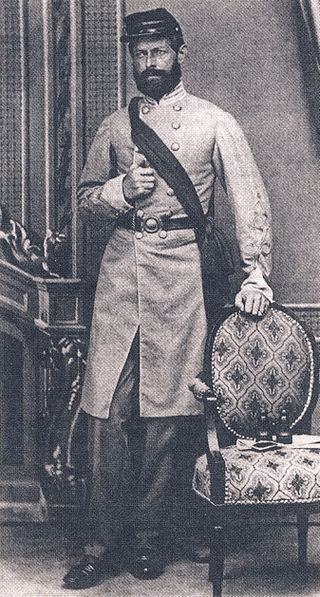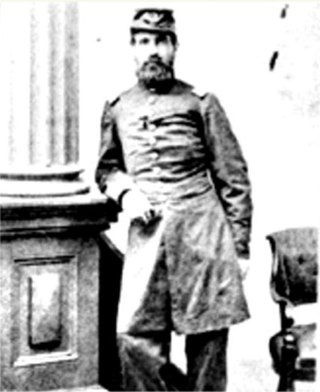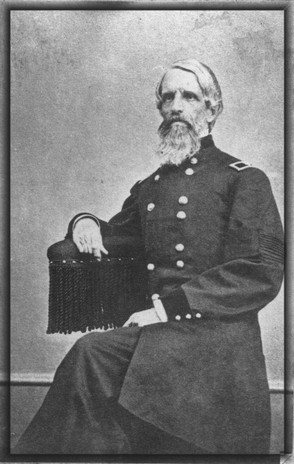
A prisoner of war (POW) is a person who is held captive by a belligerent power during or immediately after an armed conflict. The earliest recorded usage of the phrase "prisoner of war" dates back to 1610.

The postage stamps and postal system of the Confederate States of America carried the mail of the Confederacy for a brief period in U.S. history. Early in 1861 when South Carolina no longer considered itself part of the Union and demanded that the U.S. Army abandon Fort Sumter, plans for a Confederate postal system were already underway. Indeed, the Confederate Post Office was established on February 21, 1861; and it was not until April 12 that the American Civil War officially began, when the Confederate Army fired upon U.S. soldiers who had refused to abandon the fort. However, the United States Post Office Department continued to handle the mail of the seceded states as usual during the first weeks of the war. It was not until June 1 that the Confederate Post Office took over collection and delivery, now faced with the task of providing postage stamps and mail services for its citizens.

Henry Wirz was a Swiss-born American military officer and convicted war criminal who served in the Confederate States Army during the American Civil War.

The Andersonville National Historic Site, located near Andersonville, Georgia, preserves the former Andersonville Prison, a Confederate prisoner-of-war camp during the final fourteen months of the American Civil War. Most of the site lies in southwestern Macon County, adjacent to the east side of the town of Andersonville. The site also contains the Andersonville National Cemetery and the National Prisoner of War Museum. The prison was created in February 1864 and served until April 1865.

Camp Douglas, in Chicago, Illinois, sometimes described as "The North's Andersonville," was one of the largest Union Army prisoner-of-war camps for Confederate soldiers taken prisoner during the American Civil War. Based south of the city on the prairie, it was also used as a training and detention camp for Union soldiers. The Union Army first used the camp in 1861 as an organizational and training camp for volunteer regiments. It became a prisoner-of-war camp in early 1862. Later in 1862 the Union Army again used Camp Douglas as a training camp. In the fall of 1862, the Union Army used the facility as a detention camp for paroled Confederate prisoners.

Camp Butler National Cemetery is a United States National Cemetery located a few miles northeast of Springfield and a few miles southwest of Riverton, a small town nearby to Springfield, in Sangamon County, Illinois. It was named for the Illinois State Treasurer at the time of its establishment, William Butler. Administered by the United States Department of Veterans Affairs, it occupies approximately 53 acres (21 ha), and is the site of 19,825 interments as of the end of 2005. Camp Butler National Cemetery was placed on the National Register of Historic Places in 1997.

Salisbury National Cemetery is a United States National Cemetery located in the city of Salisbury, in Rowan County, North Carolina. It was established at the site of burials of Union soldiers who died during the American Civil War while held at a Confederate prisoner of war camp at the site.

Elmira Prison was originally a barracks for "Camp Rathbun" or "Camp Chemung", a key muster and training point for the Union Army during the American Civil War, between 1861 and 1864. The 30-acre (120,000 m2) site was selected partially due to its proximity to the Erie Railroad and the Northern Central Railway, which crisscrossed in the midst of the city. The Camp fell into disuse as the war progressed, but its "Barracks #3" was converted into a military prison in the summer of 1864. It was the prison holding the largest number of Confederate POWs. Its capacity was 4,000, but it held 12,000 within one month of opening. A different source says that Camp Rathbun had a capacity of 6,000 recruits, but that it was turned into a prison for 10,000 and the Union Commissary General was given just 10 days to make it happen.

Daniel P. Tyler IV was an iron manufacturer, railroad president, and one of the first Union Army generals of the American Civil War.

George Washington Cullum was an American soldier, engineer and writer. He worked as the supervising engineer on the building and repair of many fortifications across the country. Cullum served as a general in the Union Army during the American Civil War, primarily in the Western Theater and served as the 16th Superintendent of the United States Military Academy. Following his retirement from the Army, he became a prominent figure in New York society, serving in many societies, and as vice president of the American Geographical Society. The society named the Cullum Geographical Medal after him.
The 28th Regiment Illinois Volunteer Infantry was an infantry regiment that served in the Union Army during the American Civil War, commanded by Colonel Amory K. Johnson and later by Lieutenant Colonel Richard Ritter.

James Adelbert Mulligan was colonel of the 23rd Illinois Volunteer Infantry Regiment in the Union Army during the American Civil War. On February 20, 1865, the United States Senate confirmed the posthumous appointment of Mulligan to the rank of brevet brigadier general of U.S. Volunteers to rank from July 23, 1864, the day before he was mortally wounded at the Second Battle of Kernstown, near Winchester, Virginia. He commanded the Federal forces at the First Battle of Lexington, and later distinguished himself in other engagements in the Eastern theater prior to his death in battle.

Camp Morton was a military training ground and a Union prisoner-of-war camp in Indianapolis, Indiana, during the American Civil War. It was named for Indiana governor Oliver Morton. Prior to the war, the site served as the fairgrounds for the Indiana State Fair. During the war, Camp Morton was initially used as a military training ground. The first Union troops arrived at the camp in April 1861. After the fall of Fort Donelson and the Battle of Shiloh, the site was converted into a prisoner-of-war camp. The first Confederate prisoners arrived at Camp Morton on February 22, 1862; its last prisoners were paroled on June 12, 1865. At the conclusion of the war, the property resumed its role as the fairgrounds for the Indiana State Fair. In 1891 the property was sold and developed into a residential neighborhood known as Morton Place, a part of the Herron-Morton Place Historic District.

African Americans, including former slaves, served in the American Civil War. The 186,097 black men who joined the Union Army included 7,122 officers and 178,975 enlisted soldiers. Approximately 20,000 black sailors served in the Union Navy and formed a large percentage of many ships' crews. Later in the war, many regiments were recruited and organized as the United States Colored Troops, which reinforced the Northern forces substantially during the conflict's last two years. Both Northern Free Negro and Southern runaway slaves joined the fight. Throughout the course of the war, black soldiers served in forty major battles and hundreds of more minor skirmishes; sixteen African Americans received the Medal of Honor.

for the inventor of the fraud proof coupon ballot, please see Moncena Dunn (inventor)

During the American Civil War, the state of Illinois was a major source of troops for the Union Army, and of military supplies, food, and clothing. Situated near major rivers and railroads, Illinois became a major jumping off place early in the war for Ulysses S. Grant's efforts to seize control of the Mississippi and Tennessee rivers. Statewide, public support for the Union was high despite Copperhead sentiment.

William Hoffman (1807–1884) was a 19th-century officer in the United States Army. The West Point graduate was involved in the Black Hawk War, Seminole Wars, Mexican–American War and the American Civil War. During the Civil War he served as the Commissary-General of Prisoners and set policy for the treatment and release of prisoners.
Joseph H. Tucker was a banker, businessman and Illinois militia colonel during the first two years of the American Civil War. He was given initial responsibility for building Camp Douglas at Chicago, Illinois, and was the first commander of the camp. Originally a training camp for Union Army recruits, in 1862 and 1863 Camp Douglas was converted into a prison camp for Confederate States Army prisoners captured by the Union Army. Tucker was commander of the camp from the start of its construction in October 1861 until September 28, 1862, except between February 26, 1862, and June 19, 1862. During this time, the camp was used as a training facility and had its initial use as a prisoner of war camp. Tucker was never mustered into the Union Army, remaining a colonel in the Illinois militia during the term of his service in the Civil War.

Between 1861 and 1865, American Civil War prison camps were operated by the Union and the Confederacy to detain over 400,000 captured soldiers. From the start of the Civil War through to 1863 a parole exchange system saw most prisoners of war swapped relatively quickly. However, from 1863 this broke down following the Confederacy's refusal to treat black and white Union prisoners equally, leading to soaring numbers held on both sides.

The Alton Military Prison was a prison located in Alton, Illinois, built in 1833 as the first state penitentiary in Illinois and closed in 1857. During the American Civil War, the prison was reopened in 1862 to accommodate the growing population of Confederate prisoners of war and ceased to be prison at the end of the war in 1865. The prison building was demolished not long after the Civil War. All that remains of the former prison site is a section of ruin wall that is maintained by the State of Illinois as an historic site. The prison site is included in the U.S. National Register of Historic Places.


















